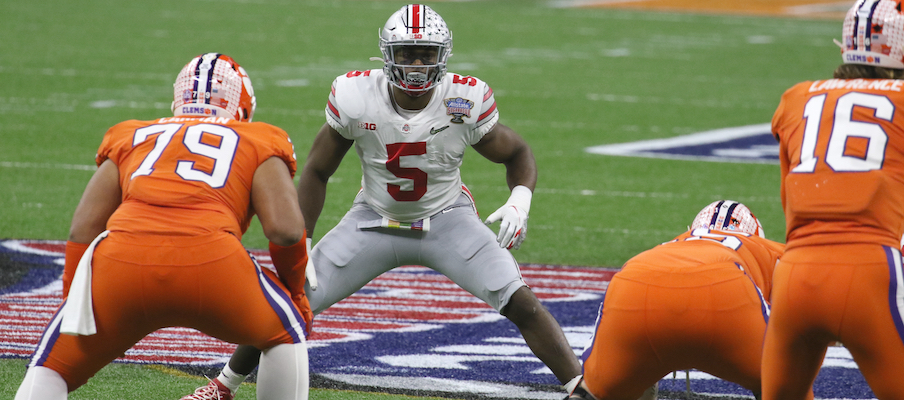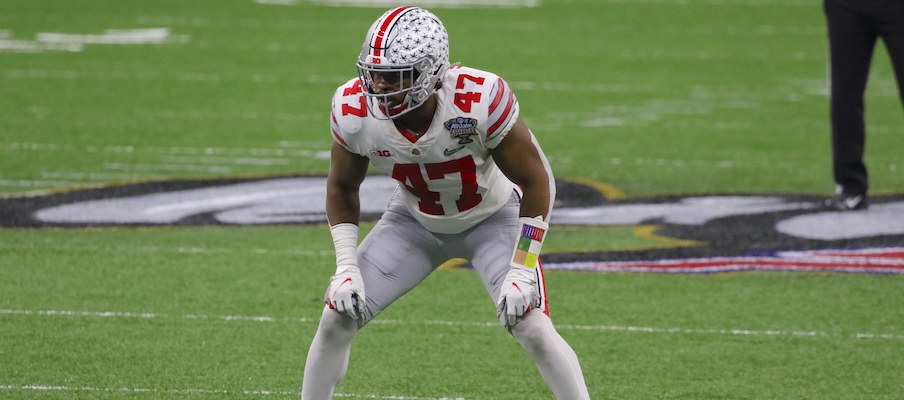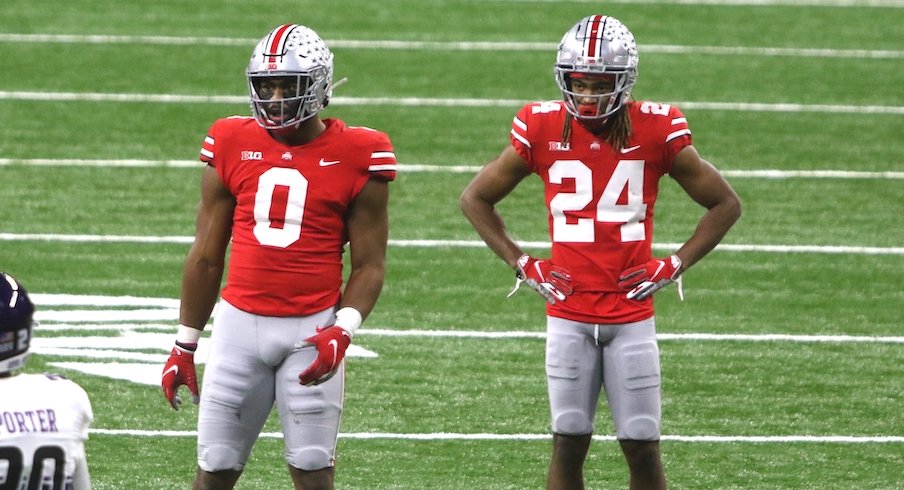The 2021 NFL Draft is just about upon us.
For Ohio State, that means it’s once again time to see another dozen or so guys head to the next level. As many as 14 Buckeyes might have their dreams realized on Thursday, Friday or Saturday. Justin Fields leads the way as a potential top-10 selection and a host of others will follow suit.
As part of our pre-draft coverage here at Eleven Warriors, we put together the cases for taking each of the possible draftees, and we begin with the only first-round lock.
Justin Fields
The total package. Fields has every athletic gift anybody could ask for in a quarterback, possesses a strong and accurate arm and is well built at 6-foot-3 and 227 pounds. He produced at a level that made him a Heisman Trophy finalist in his first year as a starter and led Ohio State to the College Football Playoff both seasons in Columbus. Drafting Fields means putting your franchise in the hands of a capable, talented, tough quarterback with the traits NFL executives and coaches always talk about wanting in somebody lining up behind center.
Wyatt Davis
Long before this year’s draft, Davis has been recognized as having an NFL pedigree and a toolset that earned him five-star status as a recruit. The combination of exceptional natural ability and football bloodlines helped get him to this point. Davis fell into a starting job late in his second season, then started the following two years, becoming a first-team All-American in 2019 then a unanimous All-American in 2020. Davis has the personality and dependability NFL teams desire and has played at a high level in some of college football’s biggest games. He’ll go early for good reason.
Pete Werner
What makes Werner such a desirable prospect in the NFL draft is his ability to fill numerous different spots on a defense. At Ohio State he was given safety-like coverage responsibilities, thrived as a blitzer and thumped as an inside linebacker. He has long been underrated as an athlete, clocking a 4.58-second 40-yard dash and jumping for a 39.5-inch vertical. NFL teams have to understand that wherever they have a need at the second level of the defense, Werner should be able to plug it. He has few holes in his game, which is why he appears to be a late riser up NFL draft boards.
Baron Browning
Quite literally, Browning is one of the most physically gifted linebackers to enter the NFL in decades. That’s not an exaggeration. He proved himself to be a fast runner, explosive sprinter and exceptional leaper with great change of direction at the pro day. In a program filled with elite athletes, it's hard for somebody's athleticism to stand out, but that's what happened with Browning who comes into the NFL at a chiseled 245 pounds. He had to learn several spots in Ohio State’s defense, playing on the outside, as a middle linebacker and rushing off the edge. The versatility and physical traits should make it easy for an NFL team to talk itself into him.

Josh Myers
With what Ohio State has produced in recent years and what’s coming down the pike, Greg Studrawa appears dead-set on making this program known as Center U. Myers is up next. The two-year starter was a Rimington Trophy finalist last season, has the ability to play multiple positions on the interior of the line and has long thrived as a run blocker. He’s strong, reliable, has played through injuries and has the potential to turn into an NFL starter.
Tommy Togiai
Because Togiai only started one season, played three years of college ball and is 21, he’s more of a moldable nose tackle than many at his position who head to the NFL. In other words, the best is likely still yet to come. He wreaked havoc on the interior in the College Football Playoff semifinal and recorded three sacks against Penn State earlier in the year. NFL teams that both want somebody with a safe floor – due to his ridiculous strength, sneaky speed and high motor – and an unknown ceiling will target him in the draft. It should be easy for one of them to talk themselves into him.
Shaun Wade
At his best, Wade was in the mix for a first-round NFL draft selection following 2019. Then he moved outside and played through an injury in 2020 when he put together a subpar season. An NFL team that buys into Wade – who has good size, length and speed – recapturing the performances that led his stock to rise as a redshirt sophomore will snag him at some point over the next few days. His physicality and coverage ability in the slot is what made him special and where an NFL team could put him to maximize his production.
Trey Sermon
The enticing part about Sermon is simple: At his best, he was one of the best running backs in college football. His 331 yards and two touchdowns against Northwestern followed by 193 yards and a touchdown to help beat Clemson will go down in Ohio State lore as arguably the best two-game running back performance ever. Sermon, who averaged 7.5 yards per carry before his injury in the national championship game, found his groove later than expected in the 2020 season. But once he got comfortable, he was borderline unstoppable. An NFL team that sees his skillset as a tailback fitting into their scheme will take a shot on somebody who looked like such a quality ball-carrier late last season.
Jonathon Cooper
Off the field and as a leader, Cooper has just about every trait NFL teams could want, which will help his draft stock. After an injury-marred 2019 season that ended with an unexpected redshirt, he came back to put together what was by far the best campaign of his Ohio State career in 2020 with 3.5 sacks and numerous pressures. The high-motor defensive end can play inside and has tried to work on his stand-up linebacker ability, too. NFL teams can sell themselves on Cooper as a higher-floor draft pick than many others currently projected to get selected around him.
Justin Hilliard
While the concerns over Hilliard’s injuries are unavoidable, what’s also true is that whichever NFL team gets him will land a linebacker whose talent is better than you’d usually get in the round in which he gets picked. At times in 2020, he looked like Ohio State’s best linebacker. He played a coverage-heavy strongside linebacker role last season then showed up to the pro day to rep 225 pounds 27 times on bench press, showing some of the strength required to be an in-the-box linebacker. As long as he stays healthy, Hilliard should be able to carve out a career in the NFL.

Tuf Borland
Everybody understands the concerns about his athleticism, but the NFL team that gives him a shot will do so understanding the role he fills: A two-down, run-stopping middle linebacker who will contribute as a special-teamer and bring the traits expected of a three-time team captain. Borland’s physical limitations don’t negate the fact that he was good enough that Ohio State – through two linebackers coaches – kept him on the field as a starter for the majority of the past four years. His leadership and experience on one of college football’s most powerful teams are assets for the NFL.
Luke Farrell
If an NFL team wants a block-first tight end it can depend on who can provide value as a late-round pick, it could do much worse than selecting Farrell. His 6-foot-6, 258-pound frame will translate to the next level, he has blocked high-level athletes both in games and practices for years, and he has proven a decent enough pass-catcher that he’s not simply a sixth offensive lineman. Executives will be hard-pressed to find somebody more team-oriented in their approach than Farrell, who has a defined role he can fill at the next level.
Drue Chrisman
The four-year punter for the Buckeyes has been recognized as one of college football's best at his position ever since becoming a Ray Guy Award semifinalist as a redshirt freshman in 2017. He managed to largely remain consistent throughout his entire collegiate career, averaging 43 to 45 yards per boot in all four seasons. Anybody who remembers the 2018 Michigan State game knows how much of an impact Chrisman can have on a game.
Blake Haubeil
The three years that Haubeil kicked for Ohio State, he was a dependable option Urban Meyer and Ryan Day could rely on. He nailed his only attempt from 50-plus years, went 7-for-9 on kicks from 40-49 yards and made all 146 extra points he attempted across his career. Due to the nature of kicking for the Buckeyes, Haubeil has experienced the pressure cooker of serving as a placekicker in high-intensity moments. He’s 8-for-9 on field goals in the postseason over the past two years.


